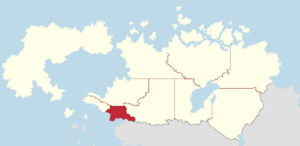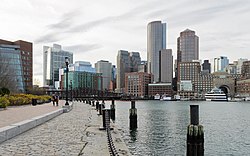New Sylvagne
This article is incomplete because it is pending further input from participants, or it is a work-in-progress by one author. Please comment on this article's talk page to share your input, comments and questions. Note: To contribute to this article, you may need to seek help from the author(s) of this page. |
New Sylvagne
Nouvelle-Sylvagne | |
|---|---|
Province | |
| Motto(s): Res, non verba (Solarian) "Actions, not words" | |
 Map of Cassier with New Sylvagne in red | |
| Country | |
| Capital (and largest city) | Bellevue |
| Largest metro | Greater Bellevue |
| Confederation | 1 July, 1757 |
| Government | |
| • Premier | [name] |
| • Governor | [name] |
| • Legislature | Council of New Sylvagne |
| Area | |
| • Total | 148,395.52 km2 (57,295.83 sq mi) |
| • Rank | 7th |
| Population (2018) | |
| • Total | 7,543,062 |
| • Density | 50.54/km2 (130.9/sq mi) |
| Time zone | UTC+9 (Western) |
| Abbreviation | NS |
| Prefix | E, F, G |
| ISO 3166 code | CA-NS |
| Rankings include all provinces and territories | |
New Sylvagne is a province in western Cassier, and its second most populous. It borders the Gulf of Chicadia and Vehemens Ocean to the west, the province of Chicadia to the west, Monbec to the north, Breloux to the east, and the Rizean states of New Estmere and Charlotte. The capital of New Sylvagne is the historically significant city of Bellevue, which is also its most populous city. It is the second smallest province in terms of area at 148,395.52 square kilometres, however it is Cassier's second most populous and its most densely populated province, with a total of 7,543,062 inhabitants at 50.54 persons per square kilometre.
Bellevue was the site of one of the first important settlements in Cassier; Fort Saint-Charles; which was founded in 1540 by Gaullican explorer Rogerin Dumont on his third voyage. Bellevue itself was founded by expelled Amendists from Gaullica in 1608 as a part of the colony of Chicadia, where many other religious and ethnic minorities from Gaullica were expelled to throughout the early colonial period. New Sylvagne split from Chicadia as a separate colony in New Gaullica in 1750, before confederating along with the colonies of Chicadia, Terre-Belle, Lower Cassier, and Upper Cassier, into the Domain of Cassier in 1757. The province played a major role during the Patriote Rebellion, where Chicadians and other opponents of the colonial government in Cassier sought to free themselves from Gaullican rule. New Sylvagne was also the location of several battles in Beaver Wars, in which a large portion of the province up to the Fraîche River was briefly controlled by Rizealand before ultimately returning to Cassien rule following the wars' conclusions. The province was the first region of Cassier to be transformed by the effects of industrialization, initially centered on the Noire, Saint Charles, and Ouinipésauguie River Valleys. From the 20th century to the present, the province of New Sylvagne has been highly influential on the political, scientific, commercial, and cultural histories of Cassier. Many important moderate and progressive movements have originated from New-Sylvagne, and the province has produced more Cassien Presidents than any other province, as well as several notable political figures.
The physical geography of New Sylvagne is diverse despite making up only 1.58 percent of Cassier's land area. The coastal region is characterized by a narrow coastal plain, while the western and northern regions are dominated by the eroded hills and peaks of the northern end of the Charbagne Mountains. Its geography has also enabled the province to take advantage of its many rivers as a source of energy and infrastructure throughout its history.
Etymology
The colony that became the province of New Sylvagne was founded upon the partition of Chicadia into two areas which ultimately became the provinces of Chicadia and New Sylvagne in 1750. The new colony was named New Sylvagne (Gaullican: Nouvelle-Sylvagne), after the Gaullican region of Sylvagne. The name Sylvagne itself is derived from the Solarian word Silvia, meaning "forest" or "woods".
Geography
New Sylvagne's landscape is characterized by low hills, mountains, and a jagged coastline shaped by the retreat of ice sheets approximately 18,000 years ago during the last glacial period.
The Charbagne Mountains are the dominant landform along New Sylvagne's eastern border with Breloux and throughout its northernmost regions. The mountains extend northwards from New Estmere and Charlotte into New Sylvagne as the Touconoc Mountains, further inland as the Loup Mountains, and then as the Socoquis Mountains into Monbec and Chicadia. Mont Waumbeck is the highest peak on the western Cassien mainland, although it is not among the ten highest peaks in western Cassier.
The coast of the province, extending from northern New Estmere to Chicadia, is permeated by freshwater bodies, hills, wetlands, and sandy beaches. Important valleys in the region include the Cygne, Fraîche, Noire, and the Ouinipésauguie River Valleys, the longest being the Cygne, which flows from the Touconoc Mountains before emptying into the Gulf of St. Croix. Castor Lake, which forms part of the border between New Sylvagne and Monbec, is the largest lake in the province.
Climate
The climate of New Sylvagne is predominantly within marine and continental zones, though conditions can vary significantly throughout the province.
The areas in the north and east, particularly near the Charbagne Mountains, have a humid continental climate. Winters are generally long and cold, receiving an average of 2,500 mm of snow annually. Summers are warm and mild though short, and rainfall is spread through the year. Many of its highest peaks have a subarctic climate, the tallest of which support alpine or tundra climates at their summits.
The areas closer to the coastline experience a humid continental climate, with warmer, hot summers, and shorter, less snowy winters. The Southernmost and coastal areas see a transition from the cold continental climates of the north and east to a milder, oceanic climate. The frost free season is among the longest in western Cassier, with winters tending to be much milder compared to the rest of New Sylvagne. Tropical cyclones have struck New Sylvagne, especially in coastal areas near the Gulfs of Chicadia and St. Croix.
Demographics
As of 2018, the province of New Sylvagne had a population of 7,543,062, making it the second most populous province in Cassier. Bellevue is unequivocally the province's largest city and metropolitan area, and is the third largest urban centre in the country. Similarly to the provinces of Terre-Belle and Chicadia, the majority of New Sylvange's population resides either near the coasts or within the metropolitan area of its largest city.
As a result of its highly urbanized, south-concentrated population, the population density of New Sylvagne varies dramatically from region to region; a characteristic shared with most Cassien provinces. Roughly three-quarters of its inhabitants, and most of the major cities, are located at or within 100 kilometres of the coastline. This is contrasted by the sparsely populated regions inland, with some reporting a population density below the national average of 4.25 persons per square kilometre.
The overwhelming majority of New Sylvagne's inhabitants are white-Eucleans who spoke Gaullican as their first and primary language.
| Largest urban centers by population | |||||||
|---|---|---|---|---|---|---|---|
| Rank | City | Population (2018) | |||||
| 1 | Bellevue | 617,000 | |||||
| 2 | Champbourg | 181,000 | |||||
| 3 | Ouabossett | 178,000 | |||||
| 4 | Printempsville | 153,000 | |||||
| 5 | Baudre | 144,000 | |||||
| 6 | Sainte-Anne | 122,000 | |||||
| 7 | Pont Royale | 121,000 | |||||
| 8 | Charlesville | 105,000 | |||||
| 9 | Neubourg | 102,000 | |||||
| 10 | Mont Château | 101,000 | |||||



